-
![]() Where Are the Videos in Google Photos? How to Find?
Where Are the Videos in Google Photos? How to Find? December 12,2025
December 12,2025 6 min read
6 min read -
![]() Data Recovery Software with Original File Names [Full Guide in 2025]
Data Recovery Software with Original File Names [Full Guide in 2025] December 12,2025
December 12,2025 6 min read
6 min read -
![]() EaseUS Data Recovery Wizard Technician 14.2 Crack + License Code
EaseUS Data Recovery Wizard Technician 14.2 Crack + License Code December 15,2025
December 15,2025 6 min read
6 min read -
![]() [Official & Latest] EaseUS Data Recovery Wizard License Code 18.1.0
[Official & Latest] EaseUS Data Recovery Wizard License Code 18.1.0 December 12,2025
December 12,2025 6 min read
6 min read -
![]() Where Is the Recycle Bin in Windows 10/11, How to Find and Open Recycle Bin
Where Is the Recycle Bin in Windows 10/11, How to Find and Open Recycle Bin December 12,2025
December 12,2025 6 min read
6 min read -
![]()
-
![]()
-
![]() Free Download Professional Data Recovery Software with Crack
Free Download Professional Data Recovery Software with Crack December 12,2025
December 12,2025 6 min read
6 min read -
![]() How to Fix Steam Uninstalled My Game Automatically [PC Solutions]
How to Fix Steam Uninstalled My Game Automatically [PC Solutions] December 12,2025
December 12,2025 6 min read
6 min read -
![]() How to Fix Hitachi Hard Drive Not Working/Recognized
How to Fix Hitachi Hard Drive Not Working/Recognized December 12,2025
December 12,2025 6 min read
6 min read
Page Table of Contents
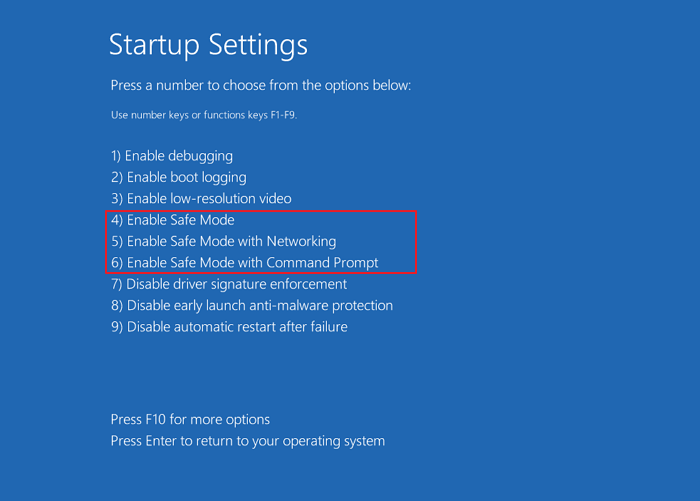
Quick Access - How to Boot to Safe Mode in Windows 10
- At the sign-in screen, select "Power > Restart" and hold the Shift key down.
- After your PC restarts to the "Choose an Option" screen, select "Troubleshoot > Advanced options > Startup Settings > Restart".
- After your PC restarts, a list of options should appear. Select "4" or "F4" to start your PC in Safe Mode.
What Is Windows 10 Safe Mode and Why You Use It
Although Windows 10 is very versatile and powerful, it gets problems sometimes. Thus, starting your computer in Safe Mode is a handy way to diagnose and fix common issues with your PC. (Windows 10 stuck on the loading screen)
Safe Mode is a built-in diagnostic mode of Windows 10 (8, 7, etc.). It starts Windows in a basic state with a limited set of files and drivers. If a problem doesn't happen in Safe Mode, this means that default settings and basic device drivers aren't causing the issue. Checking Windows in Safe Mode enables you to narrow down the source of a problem, and can help you troubleshoot problems on your PC.

Windows 10 offers three types of Safe Mode. You can choose to boot Windows 10 in any type of Safe Mode according to your needs.
Enable Safe Mode
In this mode, the operating system is started with the bare minimum of installed drivers, and only the main Windows functions are used.
Enable Safe Mode with Networking
In this mode, the network drivers are also started.
Enable Safe Mode with Command Prompt
In this mode, the operating system is started in text mode. This mode requires knowledge of computer commands and is, therefore, more suitable for professional users.
If you want to know more details about Safe Mode, you can go to Wikipedia to get additional information.
How Do I Start Windows 10 in Safe Mode (Official Tips)
If you are familiar with Windows 10, you may have noticed that pressing the F8 or the Shift + F8 keys on your keyboard to enter Safe Mode no longer works. The process to enter Safe Mode has changed. How to start Windows 10 in Safe Mode, including when your PC doesn't boot correctly, or when you can't log into Windows 10? Here are six ways to start Windows 10 in Safe Mode (the full guide):
- 1. Start Safe Mode Directly from Windows 10
- 2. Enter Safe Mode from the Sign-in Screen
- 3. Restart Windows 10 in Safe Mode by Msconfig
- 4. Enter Safe Mode from the Settings App
- 5. Start Windows 10 in Safe Mode from a Black Screen
Solution 1. Start Safe Mode Directly from Windows 10
If you can log in to Windows 10, you can boot into Safe Mode in Windows 10 directly from your Start menu. Here are the detailed steps in booting into Windows 10 Safe Mode.
Step 1. Click the Windows button and select "Power".

Step 2. Hold the "shift" key on the keyboard and click "Restart".

Step 3. Click the "Troubleshoot" option.
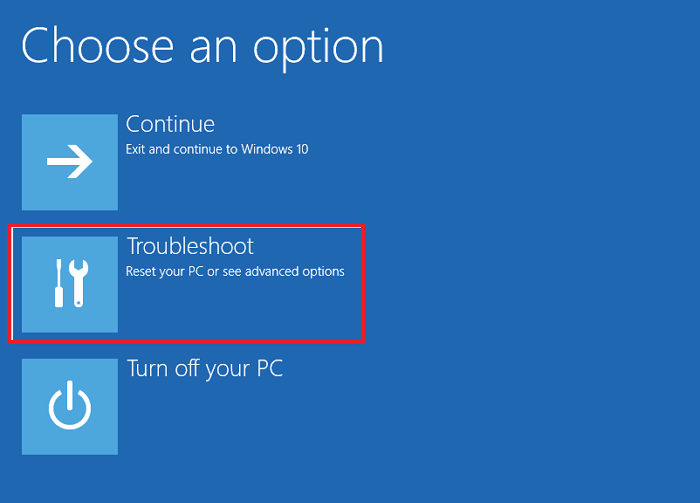
Step 4. Then, select the "Advanced options".
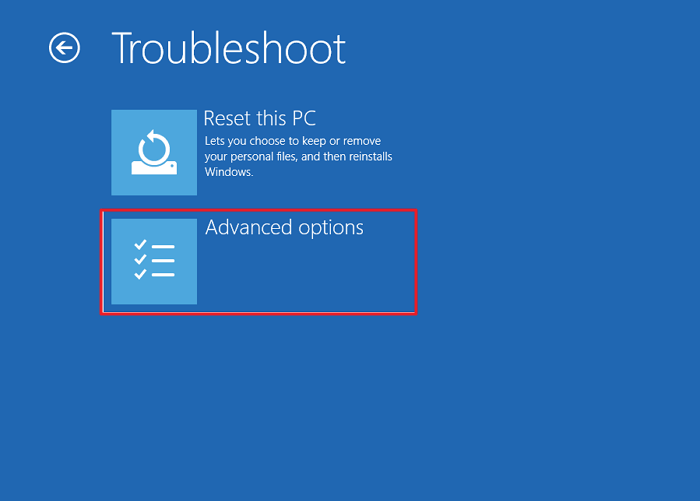
Step 5. Go to "Advanced options" and click "Start-up Settings".
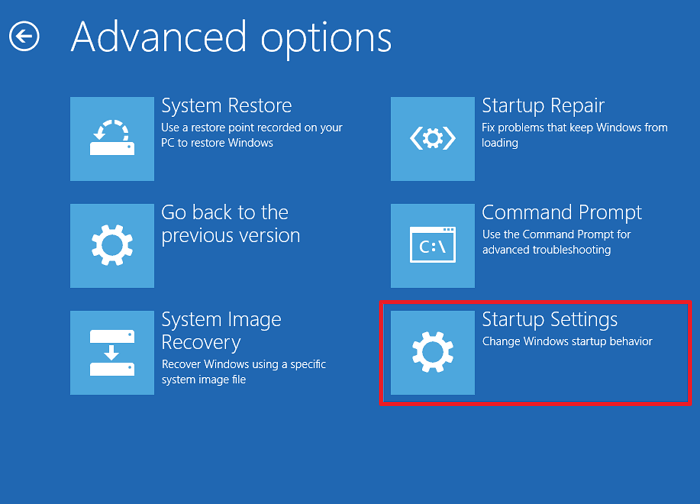
Step 5. Under "Start-up Settings" click "Restart".
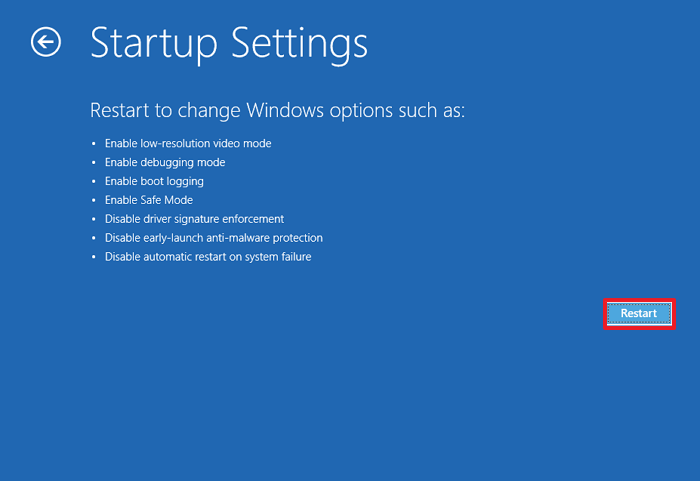
Step 6. Various boot options are displayed.
- The relevant options for booting in Safe Mode are numbers, 4,5, or 6.
- Select an option by pressing one of the numbers or function keys F4, F5 or F6

Then, Windows 10 starts in Safe Mode. You can solve your problems in Safe Mode.
Solution 2. Enter Safe Mode in Windows 10 from the Sign-in Screen
If you cannot log into Windows 10, but you can get to the sign-in screen, you can enter Safe Mode by using Shift + Restart.
Step 1. Restart the Windows 10 PC. When you see the Sign-in screen, press the "Shift" key and don't release, and click the Power icon at the bottom-right and choose "Restart".

Step 2. Windows 10 restarts and asks you to select an option.
- Choose "Troubleshoot" > Advanced options" > "Startup Settings" > "Restart".
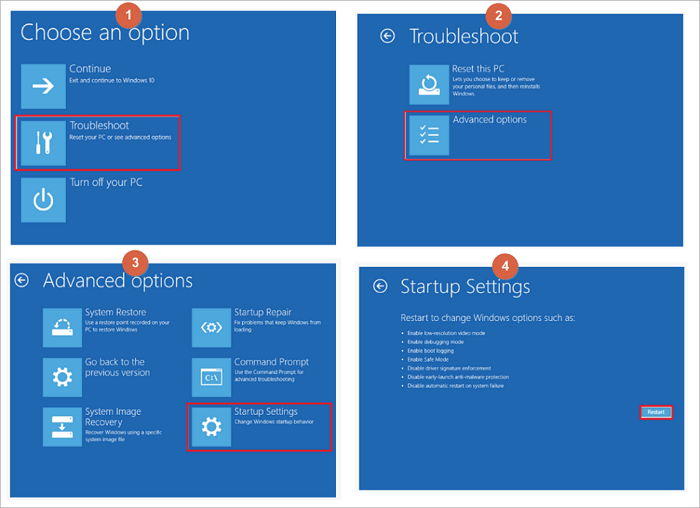
After the Windows 10 PC restarts, you can see a list of Windows startup options. Press F4 to boot Windows 10 in Safe Mode, or press F5 to start in Safe Mode in Windows 10 with Networking.
Solution 3. Restart Windows 10 in Safe Mode by Windows System Configuration
You can also try another way to boot into Safe Mode in Windows 10 if you can enter Windows 10 system normally.
Step 1. Press Windows + R key, input msconfig, and hit "Enter" to open the System Configuration utility.

Step 2. Click the "Boot" tab. Under Boot options, you can choose a "Safe boot" option based on your own need.
- Minimal equals Safe Mode.
- Alternate shell refers to Safe Mode with Command Prompt.
- Network refers to Safe Mode with Networking.
- Active Directory repair option is used to repair the Active Directory server.
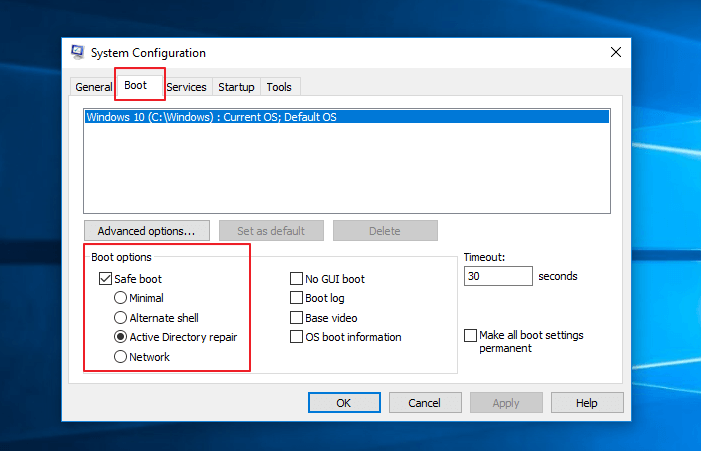
Usually, you can choose either the Minimal or Network option to start Windows 10 in Safe Mode to troubleshoot problems in Windows 10 system.
Solution 4. Enter Windows 10 Safe Mode from the Settings App
If you can log in to Windows 10, this way also enables you to boot into Safe Mode.
Step 1. Press Windows + I and head to the "Update & security" section.
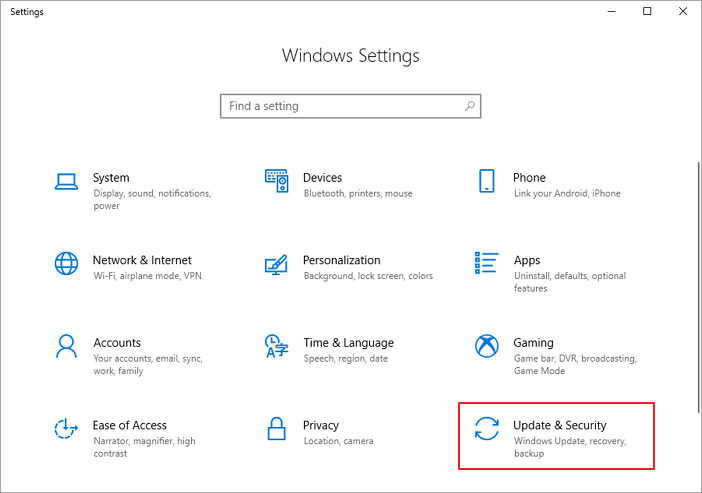
Step 2. On the left panel, press "Recovery". On the right side of the app, click or tap the "Restart now" button.
Step 3. After Windows 10 restarts, choose "Troubleshoot" > Advanced options" > "Startup Settings" > "Restart". Follow the same steps as those shown in Solution 1 from this guide.
Solution 5. How to Start Windows 10 in Safe Mode from a Black/Blank Screen
If your computer cannot boot the system successfully, you will need to directly enter Windows Recovery Environment (WinRE).
Step 1. To do this, you will repeatedly turn your device off, then on:
- Hold down the power button for 10 seconds to turn off your device.
- Press the power button again to turn on your device.
- On the first sign that Windows has started (for example, some devices show the manufacturer's logo when restarting) hold down the power button for 10 seconds to turn off your device.
- Press the power button again to turn on your device.
- When Windows restarts, hold down the power button for 10 seconds to turn off your device.
- Press the power button again to turn on your device.
- Allow your device to fully restart. You will enter winRE.
Now that you are in winRE, you will follow these steps to take you to safe mode:
Step 2. On the Choose an option screen, select "Troubleshoot > Advanced options > Startup Settings > Restart". Follow the same steps as those shown in Solution 1 from this guide.

After your device restarts, you'll see a list of options. Select option 5 from the list or press F5 for Safe Mode with Networking.
Solution 6. How to Boot in Safe Mode Windows 10 While Booting through F8 Key
Note: This method doesn't work for UEFI legacy and SSD drives.
In Windows 7, you were able to press F8 just before Windows got loaded, to open the "Advanced Boot Options" window, where you could choose to start Windows 7 into Safe Mode. But in Windows 10, you can't do that. Some people advise you to press Shift + F8 just before Windows 10 starts loading so that you make it launch the recovery mode, from where you can boot into Safe Mode.
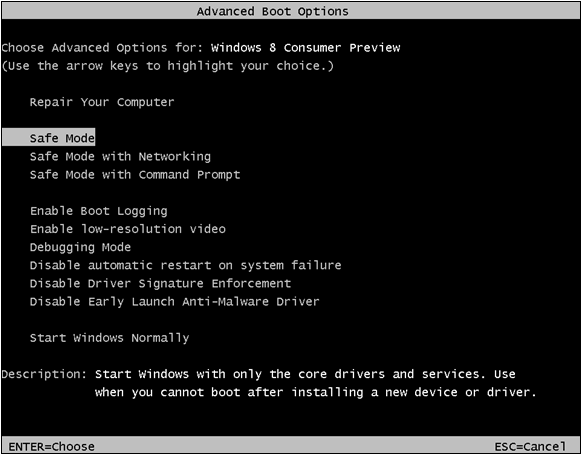
The truth is that Shift + F8 and F8 do not work in Windows 10. If you have a modern PC with a UEFI legacy and a fast SSD drive, there is no way you can interrupt the boot procedure with your keypresses. Only Windows 7 and Windows 8 users can enter Safe Mode using F8.
How to Tell If You're in Safe Mode
How do you know that you have entered Windows 10 Safe Mode? While in Safe Mode, the Desktop background is replaced with black. There are the words Safe Mode at all four corners. The top of the screen also shows the current Windows build and service pack level.

How to Exit Windows 10 Safe Mode Easily
If you Want to exit safe mode, you can follow these steps.
- Press the Windows logo key + R.
- Type msconfig in the Open box and then select "OK".
- Select the "Boot" tab.
- Under Boot options, clear the "Safe boot" checkbox.
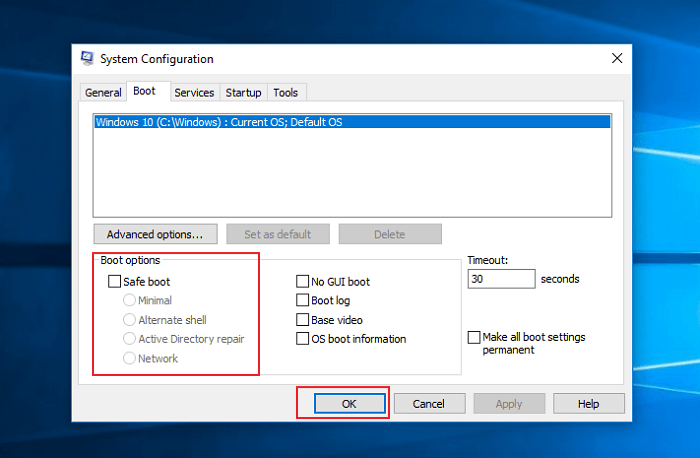
How to Troubleshoot Windows 10 Computer Issues in Safe Mode
Starting your Windows 10 PC in Safe Mode can help you fix some problems with your computer. If your computer or laptop gets infected by a virus, data recovery software is highly recommended. EaseUS Data Recovery Wizard makes data recovery easy even your computer can't boot or even can't start in Safe Mode.
Step 1. Launch EaseUS Data Recovery Wizard in Windows 11/10/8/7 and choose the place where you lost data. Then, click "Search for Lost Data" to find lost data.

Step 2. After the scan, use the file format filter on the left or upper right corner to find the files you need. You can also search in the search box, which is the fastest way to find the target file. Then, you can click the "Preview" button or double-click a file to preview its content.

Step 3. Click the checkbox next to the file and click "Recover" to get back the lost data to your local storage or Cloud drive.

Then, you can troubleshoot Windows computer problems when certain parts of the OS may not function or may not work as quickly as you're used to. In Safe Mode, you can:
- Remove Malware or Virus
- Uninstall Improper Software
- Roll Back a Driver
- Update a Driver
- Perform a System Restore
Conclusion
As a diagnostic tool, you only need to boot into Safe Mode when you want to troubleshoot a problem with your device or computer. If your computer can boot normally, Solution 3 is the easiest and fastest one. If you cannot boot into Windows 10, Solution 5 is my recommendation.
Was this page helpful?
-
Cedric Grantham is a senior editor and data recovery specialist of EaseUS. He mainly writes articles and how-to tips about data recovery on PC and Mac. He has handled 10,000+ data recovery cases and is good at data recovery of NTFS, FAT (FAT32 and ExFAT) file systems, and RAID structure reorganization. …
-
Brithny is a technology enthusiast, aiming to make readers' tech lives easy and enjoyable. She loves exploring new technologies and writing technical how-to tips. In her spare time, she loves sharing things about her game experience on Facebook or Twitter.…

20+
Years of experience

160+
Countries and regions

72 Million+
Downloads

4.9 +
Trustpilot Score


Free Data
Recovery Software
Recover data up to 2GB for free!












